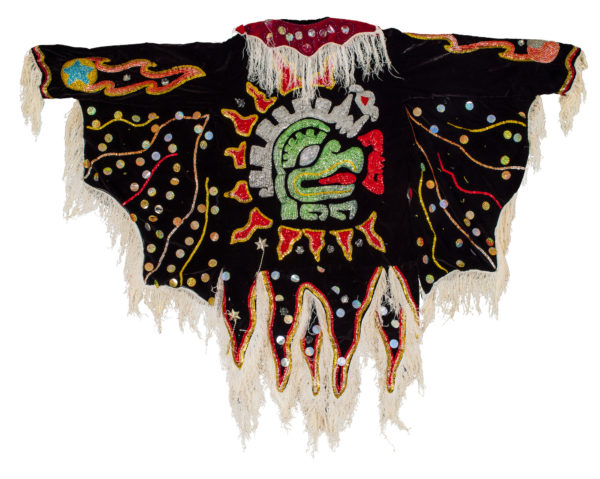
Art serves as a tool of expression for marginalized communities
to voice outrage against human rights violations and challenge ruling powers
The Museum of Anthropology (MOA) at UBC presents the powerful exhibition, Arts of Resistance: Politics and the Past in Latin America, on display from May 17 to October 8, 2018. Curated by Laura Osorio Sunnucks, MOA’s Mellon Postdoctoral Curatorial Fellow for Latin America, this premiere exhibition illustrates how Latin American communities use traditional and historic art forms to express contemporary political realities. Visitors will have the rare opportunity to view art and multi-sensory installations from Mexico, Guatemala, Peru, El Salvador, Ecuador, and Chile, with special attention to marginalized communities, while exploring the role of creativity during times of political turmoil.
“Latin American culture and folkloric arts are well known. However, we invite visitors to take a closer look and understand the political and social significance of these artistic traditions,” says Osorio Sunnucks. “Arts of Resistance will display a number of works from communities in Latin America that have been subjected to violence and state-sponsored terrorism. Through this exhibition, we are challenging established genres by exploring the links between colonial and contemporary political forces, as well as different aspects of popular culture.”
In Arts of Resistance, Osorio Sunnucks pays particular attention to the art of Indigenous rural peoples, who have historically been and continue to be excluded from mainstream national culture and society. The exhibition is inspired by MOA’s existing Latin American collection that includes art works that illustrate the tension between cultural survival and innovation. Visitors will have the opportunity to view Tigua paintings from Ecuador and amate paintings from rural Guerrero, Mexico, dating back to the development of tourism and the folkloric art boom of the 1970s. Vancouver is home to a number of refugees from the Pinochet dictatorship in Chile — a community whose resistance against the fascist regime and support for the socialist president Salvador Allende will be represented in the exhibition using a group of folkloric ceramics from Quinchamali, a town south of Santiago. These objects, displayed alongside other memory works, will show how traditional art forms conjure the culture and imagination of migrant peoples.
In addition to works from MOA’s impressive existing Latin American collection, Osorio Sunnucks commissioned more than one hundred new pieces to add to the collection, many of which she sourced from her personal research in rural towns in Mayan-speaking Mexico and Guatemala. These acquisitions include carnival costumes, Maya textiles, as well as figurative and narrative paintings that bear witness to political realities and human rights violations. Many of these pieces were purchased directly from the victims of state-sponsored violence. In some cases, the artistic practices associated with these objects are part of endangered material knowledge systems. As such, alongside resilience, resistance, and artistic innovation, these works will illustrate gaps in ancestral knowledge and the impact of colonial and neo-colonial dominance.
This illuminating exhibition will also include two multi-sensory installations. One installment includes a mural painted on site by a women’s art collective from the Amazonian Shipibo-Konibo diaspora in Lima, Peru. During the exhibition, the mural will be painted with kené, a design specific to Shipibo-Konibo people, which is also a rare example of a women-only artistic practice in the Amazon. The collective will sing and record as they paint, filling the exhibition space with their ancestral knowledge. At the exhibition’s opening ceremonies on May 17, Olinda Silvano and Silvia Ricopa, who are both members of this collective, will sing live for visitors. Another installation will be created by the Oaxacan graffiti collective, Lapiztola. They will mount a light, stencil, and sound installation, chronicling their experience of an indigenist insurgency that took place in 2006 in Oaxaca, Mexico.
Arts of Resistance is a unique opportunity for visitors to learn about Latin American politics through the lens of contemporary art—the objects on display embody important historical and cultural memories. Furthermore, the exhibition has the potential to influence how Latin American art and culture are showcased in museums and galleries. Considering the growing global mobility of people, ideas, and objects, Arts of Resistance demonstrates how museums and galleries can become sites of return and remembering, as communities use collections to reassert their identities and political agency.
About MOA (moa.ubc.ca)
The Museum of Anthropology (MOA) at UBC is world-renowned for its collections, research, teaching, public programs and community connections. Founded in 1949 in the basement of the Main Library at UBC, its mission is to inspire understanding of and respect for world arts and cultures. Today, Canada’s largest teaching museum is located in a spectacular building overlooking mountains and sea. MOA houses almost 50,000 ethnographic objects (as well as 535,000 archaeological objects managed by the UBC Laboratory of Archaeology), including many that originate from the Northwest Coast of British Columbia as well as from all over Asia (about 40 percent of MOA’s collection). The Koerner Gallery features one of Canada’s most important European ceramics collections, while MOA’s Multiversity Galleries provide public access to more than 9,000 objects from around the world. The Audain Gallery and the O’Brian Gallery, MOA’s temporary exhibition spaces, showcase travelling exhibits, as well as those developed in-house.
| LISTING INFORMATION | MOA presents Arts of Resistance: Politics and the Past in Latin America |
| Dates: | May 17 to October 8, 2018 |
| Opening: | May 17, 2018 at 7pm |
| Address: | Museum of Anthropology University of British Columbia 6393 NW Marine Drive, Vancouver, BC |
| Website: | moa.ubc.ca |
